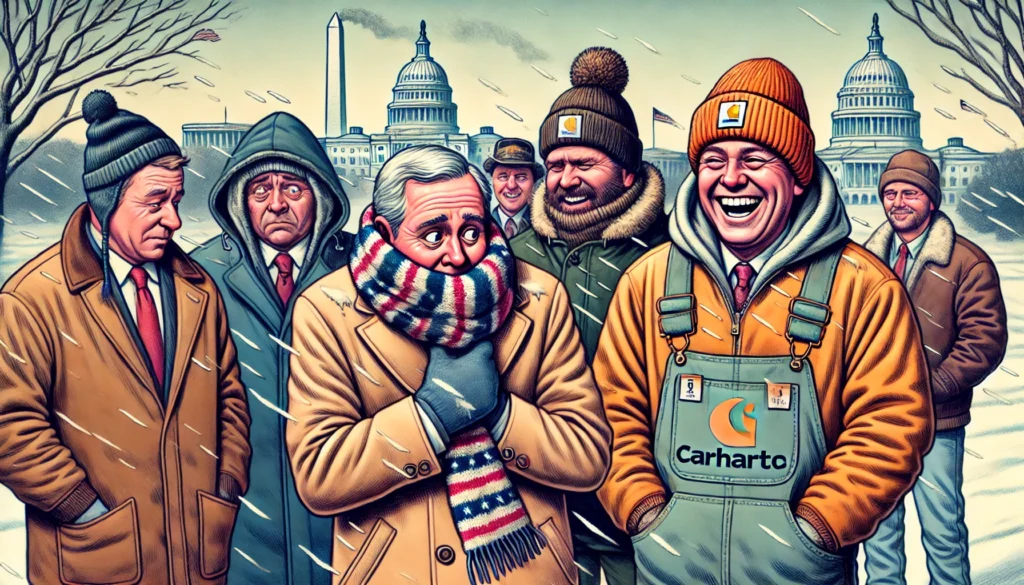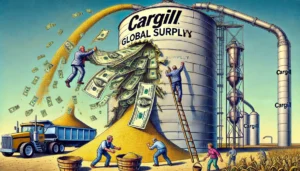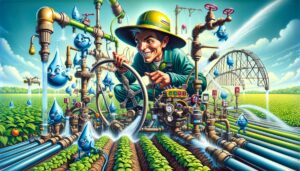
Bohney.com A satirical illustration of politicians shivering in expensive coats and scarves while farmers in rugged Carhartt jackets laugh in Alan Nafzger 1.webp.webp
Politicians Shiver, Farmers Snicker
“Ever Heard of Layering Up, Mr. President?”
By Rusty Haybale, Senior Cold Front Correspondent
The recent inauguration ceremony took a dramatic turn when Washington’s elite, swaddled in designer overcoats and clinging to hand warmers like life depended on it, faced an unexpected terror—a light winter breeze. Farmers across America, meanwhile, watched the televised spectacle from their barns, coffee in hand, shaking their heads.
A Cold Reality Check
While politicians shivered in their $3,000 wool coats, farmers across the Midwest continued their morning routine of breaking ice in water troughs and feeding livestock in subzero temperatures. “I saw the inauguration got moved inside,” chuckled Iowa cattle farmer Rick Dawson, tightening his 20-year-old Carhartt. “Must’ve been real bad out there—what was it? Thirty degrees? That’s shorts weather.”
Washington D.C. declared an emergency protocol when the wind chill dropped to a crisp 42 degrees. The mayor issued warnings, advising residents to stay indoors unless absolutely necessary. Meanwhile, in Minnesota, dairy farmer Marge Reynolds was out before dawn in negative temperatures, clearing snow with one hand and eating a breakfast sandwich with the other. “If I stayed inside every time it was cold, my cows would unionize,” she said.
The contrast was stark. The nation’s capital, a hub of powerful decision-making, came to a standstill at the very hint of winter, while farmers merely added an extra layer of flannel and carried on. “I guess nobody in Washington ever heard of thermal underwear,” muttered an old-timer at the local co-op, adjusting his weathered beanie.
D.C.’s Weather Panic vs. Rural Resilience
It’s a well-known fact that Washington shuts down over two inches of snow. The city’s public transportation halts, schools close, and federal employees receive the golden ticket of a ‘work-from-home’ day. Contrast that with the life of a farmer, where even three feet of snow isn’t enough of an excuse to skip chores.
“When the weatherman says ‘cold front,’ I check how much hay I’ve got left,” explained Nebraska rancher Tom Simmons. “When a politician hears ‘cold front,’ they check if their assistant packed their Canada Goose coat.”
The images from the indoor ceremony reinforced the long-held belief that Washington is, indeed, a bubble—one where climate change is endlessly debated, but where actual, physical weather remains a source of absolute shock. “I saw the President double-layering his scarf,” laughed Missouri hog farmer Lisa Beckett. “Meanwhile, I’m out here with frozen mud up to my knees just trying to get my pigs fed.”
One senator was caught on camera visibly shivering despite standing beneath a heated canopy. His staff later released a statement that he was “deeply affected by the elements” and needed to retreat indoors. Farmers, meanwhile, were too busy defrosting tractor engines to take notice.
Dress for Success—or for Surviving January on a Farm
While the Washington elite debated the merits of cashmere over wool, rural America continued its longstanding tradition of layering up with whatever’s been hanging in the mudroom since the Clinton administration. Farmers don’t check the temperature; they check whether or not their spit freezes before it hits the ground.
“My coat’s got holes in it,” said Ohio dairy farmer Bill Langford, patting his timeworn flannel. “Still works just fine. I don’t need some imported Italian wool nonsense.”
There’s a certain irony in politicians discussing energy policy while struggling to keep their own bodies warm. “They’re worried about wind energy,” joked Texas rancher Jake Turner. “I’m worried about the wind literally taking my hat off.”
At the inaugural ball, some guests were overheard complaining that the venue wasn’t adequately heated. Meanwhile, a farmer’s idea of a heated workspace is a barn packed with cattle. “If you’ve never defrosted your own mustache just so you can sip coffee, you haven’t lived,” said a grinning Wisconsin farmer.
An Inconvenient Frost for the Political Class
Despite all the discourse on climate change, it remains clear that many politicians are utterly unprepared for actual weather. If Congress ever attempted to pass a bill requiring representatives to spend a single January morning doing farm chores, the motion would die on arrival.
“If a politician ever had to muck out a frozen stall in February, they’d outlaw winter,” remarked Montana rancher Hank Peterson, yanking on a pair of thick gloves that had seen better days. “They’d write a bill about it—‘The Fair and Equitable Frost Reduction Act.’”
Farmers, on the other hand, don’t need committees, subcommittees, and hearings to understand the changing seasons. They don’t have the luxury of retreating indoors when the air gets brisk. They just keep moving, because animals don’t feed themselves, and tractors don’t run on government shutdowns.
A veteran legislator, wrapped in three layers of designer outerwear, was overheard lamenting that the chill was “downright cruel.” That same morning, a farmer somewhere in North Dakota was breaking ice with a sledgehammer just to get water to his cattle.
Emergency Response: A Farmer’s Perspective
It’s amusing to watch city-dwellers panic when temperatures drop. Reports of “arctic air” sweeping through D.C. prompted emergency plans for indoor accommodations. Farmers, meanwhile, prepared by simply pulling out last year’s insulated coveralls.
“The real emergency,” said Indiana farmer Mark Briggs, “is when your diesel engine won’t start at 5 AM and you’ve got 200 head of cattle waiting on breakfast.”
A well-dressed analyst on a news program suggested that the cold weather could be combated by increased federal spending on winter infrastructure. Farmers across the nation collectively laughed. “More spending? Just buy a pair of long johns and quit whining,” said one Colorado rancher.
A Lesson in Practicality
Perhaps the lesson here isn’t just about weather, but about resilience. The rural communities that feed America don’t get to take snow days. They don’t get to huddle indoors every time the wind picks up.
“You know what my winter survival kit is?” asked Kansas farmer Pete Harrison. “Duct tape, WD-40, and coffee. Maybe a candy bar if I’m feeling fancy.”
Compare that to the polished world of Washington, where a “winter emergency” includes coordinating motorcades to avoid walking more than 20 feet outside. If only they knew the feeling of stepping into a barn on a -10-degree morning, where even the cows are huddled together for warmth.
The Great Divide: City vs. Country
The biggest difference between politicians and farmers isn’t just geography—it’s mentality. In D.C., problems are theoretical. On a farm, they are immediate and real. You don’t get to debate whether or not to shovel snow when the road to the barn is blocked.
“If the government worked like a farm, things would actually get done,” said South Dakota rancher Ray Morrison. “But instead, we’ve got people standing around talking about how cold it is. Try moving a few hay bales—that’ll warm you up real quick.”
Washington may be great at writing speeches and hosting ceremonies, but when it comes to surviving a real winter, farmers will take the win every time. So, to all the politicians who struggled with a bit of cold air this inauguration season—maybe next time, just layer up.

Farmer’s Insight from the Inauguration
- A farmer’s winter coat is a 20-year-old Carhartt that has seen more action than most politicians’ careers. Meanwhile, politicians need a heated podium just to survive a light breeze.
- Farmers wake up at 4 AM to feed cattle in subzero temperatures, but a senator needs a full winter survival kit just to cross the Capitol lawn.
- The only wind chill farmers complain about is when it freezes the tractor seat solid. Meanwhile, Washington panics if the temperature drops below 50 degrees.
- Politicians are debating “climate change” while farmers are out here actually battling the climate every single day.
- When a farmer hears “cold front,” they check the livestock. When a politician hears “cold front,” they cancel their public appearance.
- If politicians had to work outside for a living, half of Congress would have frostbite by lunchtime.
- Farmers wear thermal underwear in October and don’t take them off until April. Meanwhile, politicians wear a $3,000 coat and still complain.
- Washington D.C. shuts down over two inches of snow. Farmers plow through three feet and still make it to church on Sunday.
- When a farmer says “bundle up,” it means three layers of flannel and a beanie. When a politician says “bundle up,” it means a designer scarf and cashmere gloves.
- Farmers don’t check the temperature—they check how many ice layers they have to break in the cattle trough.
- A farmer’s idea of a heated office is a barn full of cows. Meanwhile, politicians demand space heaters under their mahogany desks.
- If a politician ever had to muck out a frozen stall in January, they’d introduce a bill making winter illegal.
- Farmers don’t need fancy meteorologists to tell them it’s cold. They just step outside and if their nostrils freeze shut, it’s below zero.
- A farmer’s idea of an emergency winter kit? Duct tape, WD-40, and a thermos of coffee. A politician’s idea? A personal assistant with a Patagonia parka on standby.
- The day a politician survives one full day of calving season in February, they can start complaining about the weather. Until then, zip up and quit whining.

Originally Published at FarmerCowboy.com
2025-01-20 09:09:43
Karl Hoffman is a distinguished agriculturalist with over four decades of experience in sustainable farming practices. He holds a Ph.D. in Agronomy from Cornell University and has made significant contributions as a professor at Iowa State University. Hoffman’s groundbreaking research on integrated pest management and soil health has revolutionized modern agriculture. As a respected farm journalist, his column “Field Notes with Karl Hoffman” and his blog “The Modern Farmer” provide insightful, practical advice to a global audience. Hoffman’s work with the USDA and the United Nations FAO has enhanced food security worldwide. His awards include the USDA’s Distinguished Service Award and the World Food Prize, reflecting his profound impact on agriculture and sustainability.




